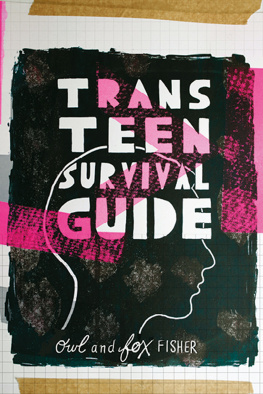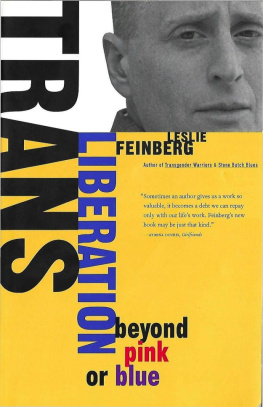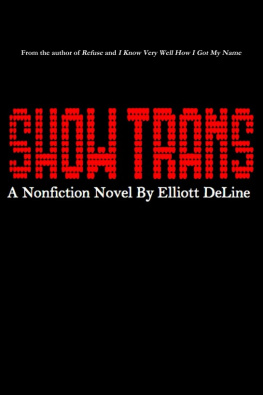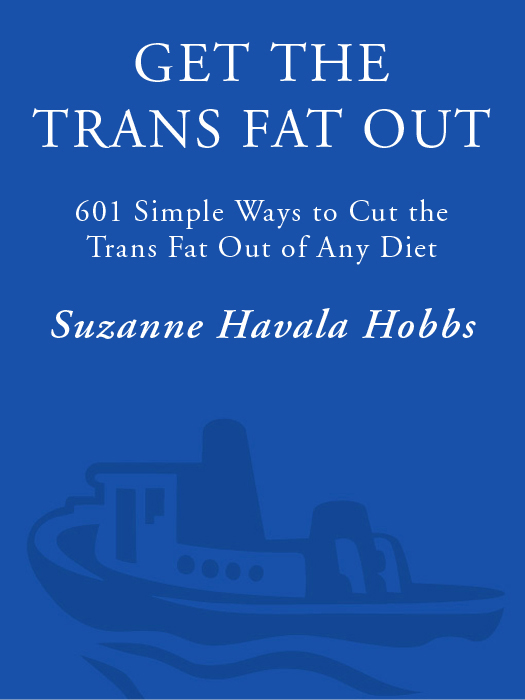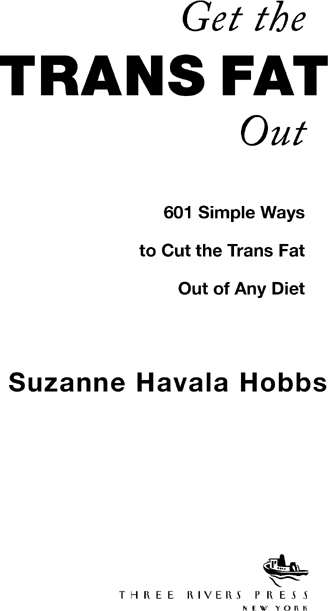Preface
T rans fat is what happens when food manufacturers add hydrogen to vegetable oil, and it is very bad for you. It contributes to obesity, and even the slightest amount in your diet raises your risk of heart disease, according to a major report by the Institute of Medicine. Eating trans fat is worse for your health than eating lard.
The problem: Trans fat is everywhere. Its in cakes, cookies, pies, muffins, fast-food french fries and sandwiches, frozen entrees, salad dressings, margarine, and more. And its elusive. Nutrition information isnt posted on the labels of fast-food products, and until recently, food packagers didnt have to reveal the amount of trans fat in their products on the foods label. Clues on ingredient labelsthe presence of partially hydrogenated vegetable oils, for examplehave long been the only practical means of learning whether a product contains harmful trans fat. Until now.
In January 2006, the federal government put into effect new regulations requiring food manufacturers to list on the food labels the amount of trans fat contained in their products. This change has set into motion a flurry of new trans-fat-free product development and the reformulation of other products.
But the world wont be rid of trans fat anytime soon. Trans fat is ubiquitous because the food industry hasnt yet found an economical substitute that functions the same way. Fast-food companies will continue to use trans fat, and while the new labeling law will make trans fat easier to find in packaged foods, most of us will still need help understanding how best to dodge it, which products are okay to eat, and how to adopt and maintain a trans-fat-free lifestyle. This book provides this information along with a quick reference fat counter that puts the newly available trans fat content of popular products at your fingertips.
In this book youll find
an explanation of what trans fat is, how it came to be, and how it affects your health.
advice on how to choose foods free of trans fat.
a complete, up-to-date fat counter listing the grams of trans fat and saturated fat in a comprehensive range of food products.
brand-specific and generic food information to help you get started.
most important, advice that puts health and nutrition information into perspective, highlighting the most pertinent facts and explaining what they mean in terms of shopping, preparing meals, and choosing foods away from home.
The biggest challenge most of us face is how to eat well. My aim in this book is to give you the information and tools you need to help yourself eat well and stay healthy. Getting the trans fat out is one vital step.
Introduction
This book will give you the basic information about trans fat: what it is, how it affects your health, and how to cut it out of your diet by choosing the right foods and planning healthy meals. When you have finished reading this book, you should be armed with knowledge and practical advice that you can put to use right away.
How to Use This Book
What information do you need to understand how to eat a diet free of trans fat? How do you prefer to learn it? Your answers to these questions will determine how you should use this book. Do what works for you. Here are some options for how to use it.
Read it from cover to cover. Reading it all will give you a comprehensive understanding of the issues. Understanding the backgroundwhat trans fat is and how it affects your healthwill help put into perspective the advice on planning meals that exclude it. A solid overview of the topic will equip you to make good decisions when youre faced with food choices.
Go surfing. Some people cant sit still long enough to read a self-help book from cover to cover (I count myself among them). Wed rather jump around, read a little here and there, and pick up ideas and inspiration along the way. Thats fine, but at the very least I recommend that you read the first section of that discuss how to read nutrition facts labels on foods and how to make sense of ingredient labels. Youll then have the fundamentals, and you can flip through the tips in the rest of the book to gain ideas and inspiration where you need them.
Troubleshoot with it. If you dont have the time to read the book now, keep it handy and use it as a reference. As you read food labels and run into snags, return to the book for a primer on label reading. If a question about the function of trans fat in foods pops into your head, go to the book for the answer. You can also use the food counter in to find out quickly if your favorite foods are sources of trans fat and then identify substitutes if you need them.
The book is meant to be a practical tool to help you learn the basics and make the best decisions about what to feed yourself and your family. The focus is trans fat, but the advice given also steers you toward choices that support overall health.
How This Book Is Organized
The book is divided into three parts.
Part I: A Trans Fat Primer offers basic scientific and health information.
fat is, how it came to be, why food companies like to use it, and where it is found.
: Trans Fat and Your Health examines the health effects of trans fatwhy it is worse for you than lardas well as how trans fat compares with other types of fats. This chapter covers dietary recommendations for trans fat, including an important report issued by the Institute of Medicine and a discussion of setting personal goals for intakes of trans fat.
: Regulations and Label Logic explains the new regulations for listing the trans fat content of foods on product labels. Sample food labels are included along with instructions for reading and interpreting the nutrition facts information and ingredient lists. Youll also learn what to do when foods dont come with a label.
: Putting It All Together puts information about trans fat into perspective and discusses the issue in the context of your total diet. Included is advice on crafting an approach to dealing with trans fat that works with your lifestyle, where to get additional help if you need it, and tips on how to get started on eliminating trans fat from your diet.











